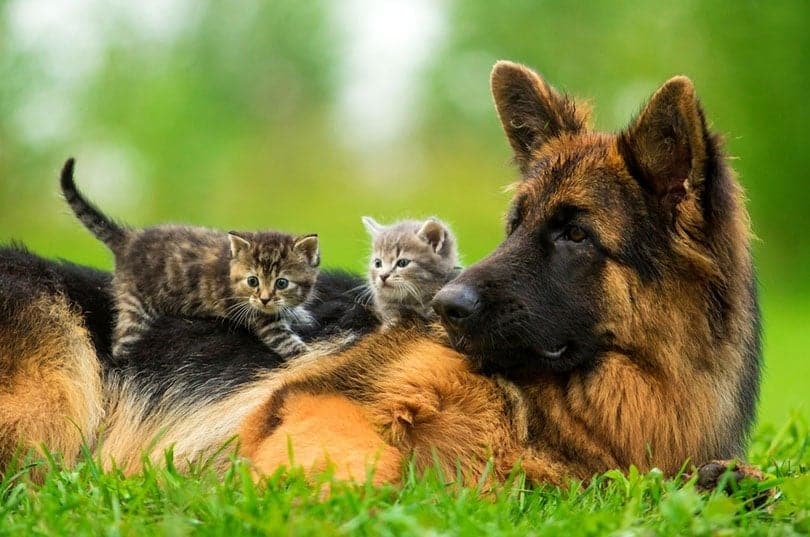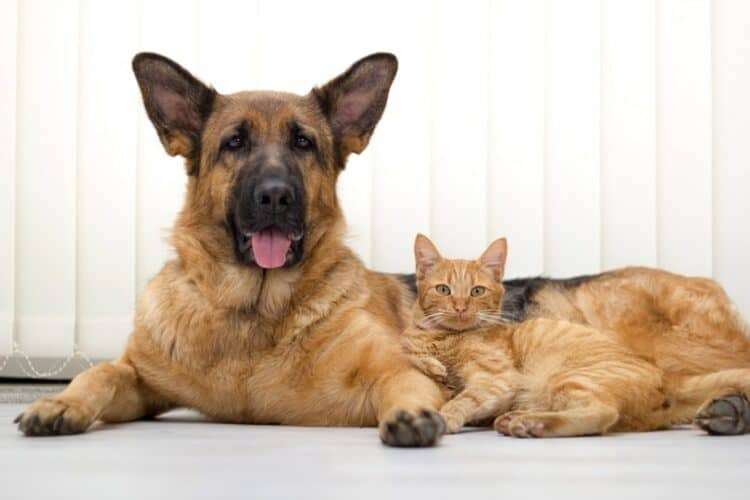German Shepherds are dogs known for their big personalities—they’re big-hearted, hardworking, and fiercely loyal to the right people. But how do German Shepherds get along with cats? There’s no clear-cut answer to this question because every dog is different. We can make generalizations about a breed’s temperament, but there are many other factors to consider.
In short, whether or not a German Shepherd will be good with cats comes down to their disposition and how well they have been socialized from a young age. Stay with us as we share more about this majestic breed and why socialization is so important for ensuring the best possible relationship between your German Shepherd and your cats.
About German Shepherds: History, Traits, and Temperament
German Shepherds were originally bred as herding dogs. In the late 19th century, German cavalry officer Max von Stephanitz, a member of the Phylax Society, was on the hunt for an excellent working dog but was struggling to find one that matched all of his criteria.
In 1899, he attended a dog show where he came across a male dog named “Hektor Linksrhein”. Impressed by the dog’s working capabilities, Stephanitz bought him.
Hektor Linksrhein—name later changed to “Horand von Grafrath”—was the first official German Shepherd. He was highly intelligent, loyal, and a solid worker—traits that were passed down to future generations of German Shepherds up to the present day.
In addition to their intelligence, loyalty, and strong work ethic, German Shepherds are a sturdy breed with strength and speed in abundance and bags of energy. They are known for being a bit aloof with strangers but not aggressive as long as they’ve been trained properly. Well-socialized German Shepherds make fantastic companions for loving dog parents with good leadership skills.
Are German Shepherds Good With Cats?
Breed aside, any dog has the potential to get along well with cats as long as they’ve been trained and socialized properly. This includes German Shepherds. When it comes to socializing German Shepherds, the earlier you start, the better—the first 3 months of their lives are the time they are the most responsive to training.
As an intelligent, high-energy breed, these dogs need consistent and capable leaders to learn good habits. Breeds that were originally working dogs, like the German Shepherd, naturally retain certain tendencies like the urge to give chase to other animals and nip at their ankles as they would have done when herding sheep to keep them in line.
The key to teaching your German Shepherd not to engage in this behavior around your cat and to interact respectfully and gently with cats is socialization.

Socializing German Shepherds to Interact With Cats
As big and bold as they may seem, German Shepherds are still uneasy about first experiences like any other dog—even those involving tiny kittens! The first steps for socializing German Shepherds involve teaching them the most basic commands like “sit” and “stay”.
This will allow you to feel more confident introducing your cat to the German Shepherd as you can use these commands if necessary. Always be on hand to closely supervise early interactions to ensure the safety of both your pets.
Avoid face-to-face interactions until your German Shepherd and your cat have become familiar with each other’s general presence and scent. Keep them in separate rooms but allow them to sniff at each other through and under the door to help them become accustomed to each other’s smell. Another good idea is to feed them at the same time on either side of the door.
The First Meeting
Again, your supervision is critical here to make sure everything goes as smoothly as possible. Place your German Shepherd in their crate/kennel or on the other side of a baby gate. Sit with your cat in front of the crate or on the other side of the baby gate for around 10 minutes. Your cat may be anxious or stressed, and if so, let them go. Don’t force them into a situation they aren’t comfortable with.
If your German Shepherd starts to behave aggressively, firmly tell them “No!”. If they continue to behave aggressively, remove both yourself and your cat from the situation. This shows your German Shepherd that you will not tolerate bad behavior and will leave if they are aggressive.
It’s likely that you will have to repeat this procedure daily over a few weeks—gradually building up the time they spend together—to desensitize both your dog and cat to each other’s presence.
When they seem to be getting used to each other and there are no signs of aggression, try introducing your German Shepherd to your cat outside of the crate or baby gate but with a leash on. This way, you can stay in control if things turn nasty.
The key to these early meetings is consistency, firmness, and a no-nonsense approach on your part. Don’t let them get away with bad behavior but also praise and encourage your German Shepherd abundantly when they respond positively to the cat’s presence. German Shepherds love being praised by their people, so will likely respond well to this.
Final Thoughts
German Shepherds, when socialized appropriately and introduced gradually to cats, are just as capable as any other dog breed of getting along with them. Introducing German Shepherds to cats takes patience and consistency, and some may need a little more time than others to get used to them.
If your German Shepherd doesn’t take well to your cat’s presence even after a few weeks, it might be time to call in the help of a professional dog trainer or behavioralist.
Featured Image Credit: VP Photo Studio, Shutterstock














